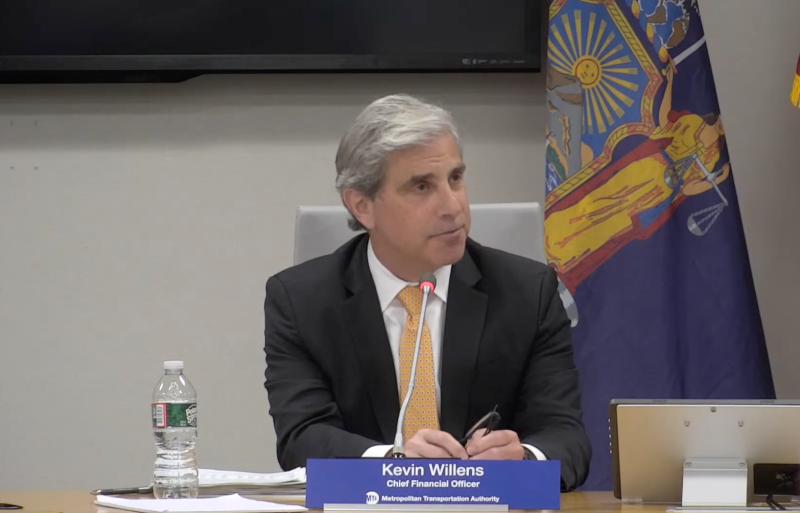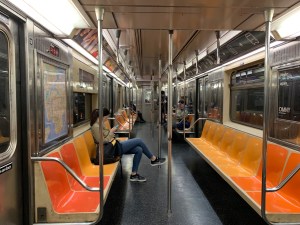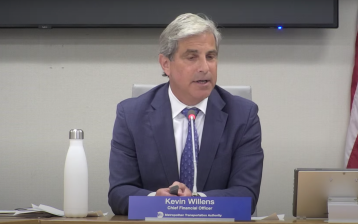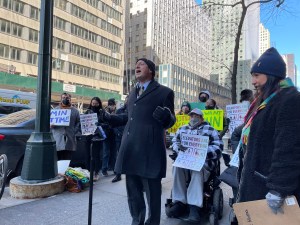MTA Admits Federal Aid May Run Out Sooner Than 2025

The MTA’s Chief Financial Officer admitted on Monday that the perpetually cash-strapped agency could wind up going through its big sack of federal money faster than it originally planned because ridership hasn’t returned at predicted levels.
CFO Kevin Willens told the MTA board that with ridership revenue now $277 million short of the original budget prediction for 2022, the money given to the agency in the American Rescue Plan would need to fill larger gaps over a shorter period of time. He notably did not say that the federal money could last through 2025 as the transit agency had initially planned in its February financial plan.
“We assume[d] the federal dollars would cover us through 2025,” he said, but “at the current ridership levels, we’ll have plenty of federal money for this year and next year.”
So through 2023 instead of 2025. And after that? “We’ll see,” Willens added, citing impending “out year gaps … based on new ridership [shortfalls].”
Yet he remained optimistic: “I think we’ll still have considerable time to work through solutions with Albany and others,” he said.
Willens quiet focus on “this year and next year” skips over the fact that the MTA’s February plan relies on $1.79 billion in rescue funds in 2024 and $1.676 billion in 2025, which reads to some observers as an admission that the financial hole is widening.
“He’s saying that the money will run out sooner than they said it would last time the MTA did their projections,” said Reinvent Albany Senior Researcher Rachael Fauss.
Even as the agency is slowly setting new pandemic-era ridership records, the ridership numbers are still well behind what they were projected to be at this point — and given the high portion of the MTA’s revenue that is based on fare collection, the agency’s bottom line is seriously endangered, Fauss said.
“I’m not saying the MTA shouldn’t celebrate its pandemic high ridership milestones, but those are still well below what they predicted. Those milestones are really important and good, but can distract from the fact that ridership is still very low compared to where they wanted it to be,” she said.
In addition to the federal recovery money that the MTA was using to fill its fiscal hole through 2025, the agency was also counting on a one-shot $499-million loan from the federal Municipal Liquidity Facility to fill a piece of the 2025 shortfall. But that shortfall was projected before the ridership revenue slump hit the MTA, which Fauss said could cause the agency to dip into its MLF loan even earlier than imagined.
The MTA’s request for federal relief money throughout 2020, and its budget assumptions, were informed by a ridership analysis done by McKinsey and Co. during the early days of the pandemic. In a best-case scenario, the consultants projected that ridership would hit 70 percent of pre-pandemic ridership by September 2021 and hit over 80 percent of pre-pandemic ridership by January 2022, while worst-case scenario from the soothsayers predicted ridership staying below 50 percent of pre-pandemic numbers until about January this year.
From January last year until about November, when the Omicron wave hit New York City, the MTA’s ridership was somewhere in between those scenarios, peaking at about 55 percent of pre-pandemic rides between September and November. But the most recent wave of the pandemic caused ridership to fall off not just the midpoint scenario but even below even the worst-case scenario for a short time.

In April, MTA Chairman and CEO Janno Lieber said that the agency had contracted with McKinsey again for a renewed ridership projection that took into account a world where remote work and working from home is becoming more locked in as a way of doing business. But as Lieber has pushed New York State to find new revenue sources for the MTA to ensure that budget gaps aren’t filled on the backs of riders, Fauss said that redoing the projections earlier would have perhaps given Albany more of a sense of urgency when legislators were hashing out this year’s budget and handing out a gas tax holiday to drivers.
“It’s not a secret that the MTA’s ridership numbers are less than their financial plan predicted them to be. I think the question is, what’s the number? And we aren’t going to see that until July. I think it does speak to the urgency of how we need to get people to focus on this problem. It’s good that [Willens] said ‘Albany’ because we do need Albany to focus on this problem. It just would have been helpful for the MTA to say is as soon as possible to the legislature. Maybe it should have been said sooner and then we wouldn’t have had this discussion of gas tax holidays,” she said.
Gov. Hochul’s Fiscal Year 2023 budget froze transit fares through the end of 2022, and did have an increased amount of state aid going towards the MTA. But that increased aid only came from subsidies and state dedicated taxes coming in at higher than predicted levels, thanks to the state’s economy improving as it came out of the pandemic. The governor and legislators didn’t find an actual new recurring revenue stream to direct to the MTA, even as some advocates pushed for the state to change the way gas taxes are distributed between the highway trust fund and mass transit operating assistance to give more of it to mass transit. (Congestion pricing, which is supposed to begin in 2023, will create revenues solely for capital repairs, not day-to-day operating funds.)
In March, Lieber said that he wasn’t worried that the MTA hadn’t locked in a new funding stream this year, because he said that discussion would be a multi-year process floated on in part by the increased state subsidies and existing federal aid.
“I never expected that this would be addressed in the current legislative session,” he said. “We’ve used the time this year as the state is trying to settle its new budget post-COVID to educate people about where we are. I think we’ve done a reasonably good job of raising the issue. And we need there to be time for the legislature and the policy community to look at different options.”




